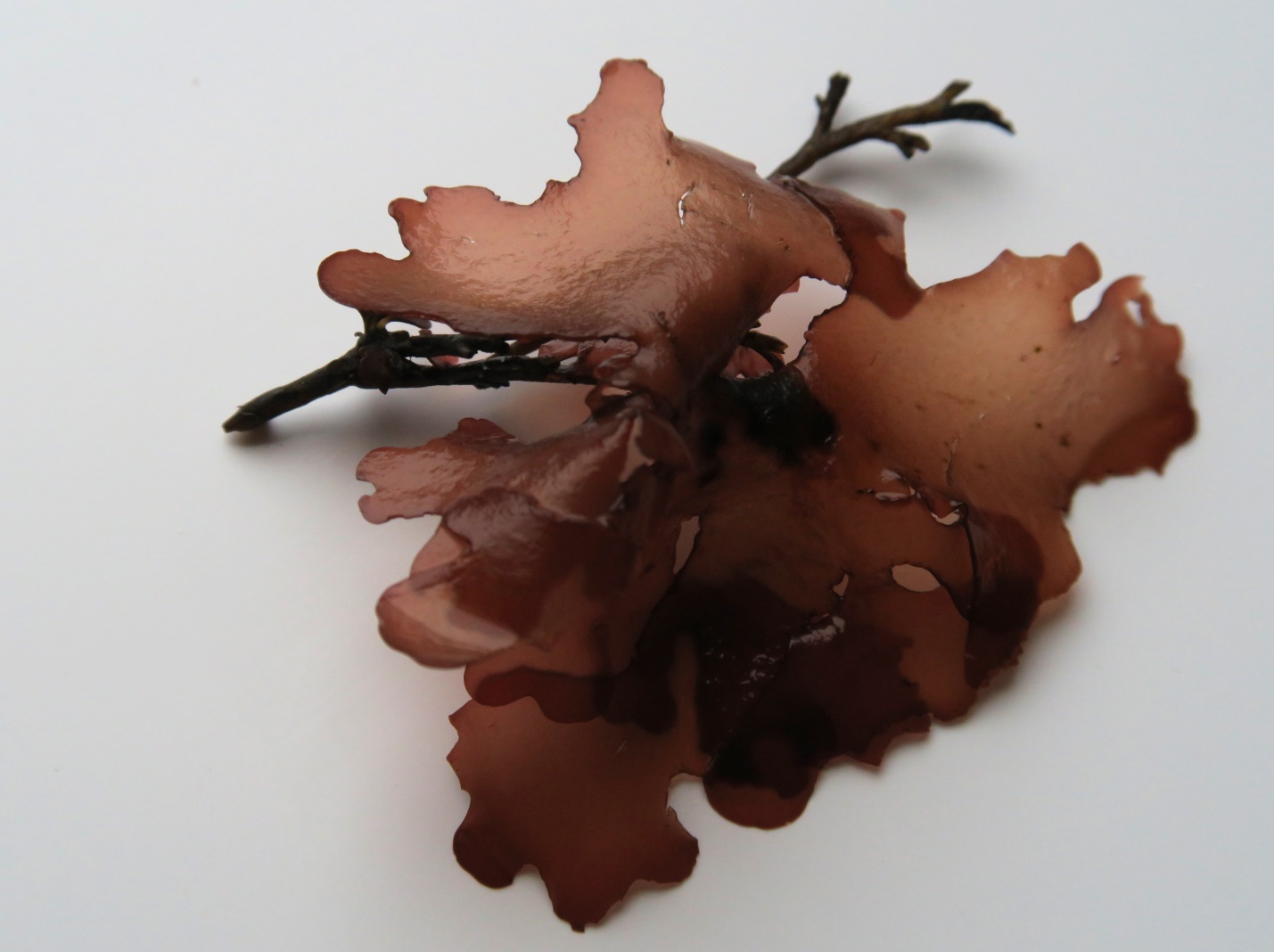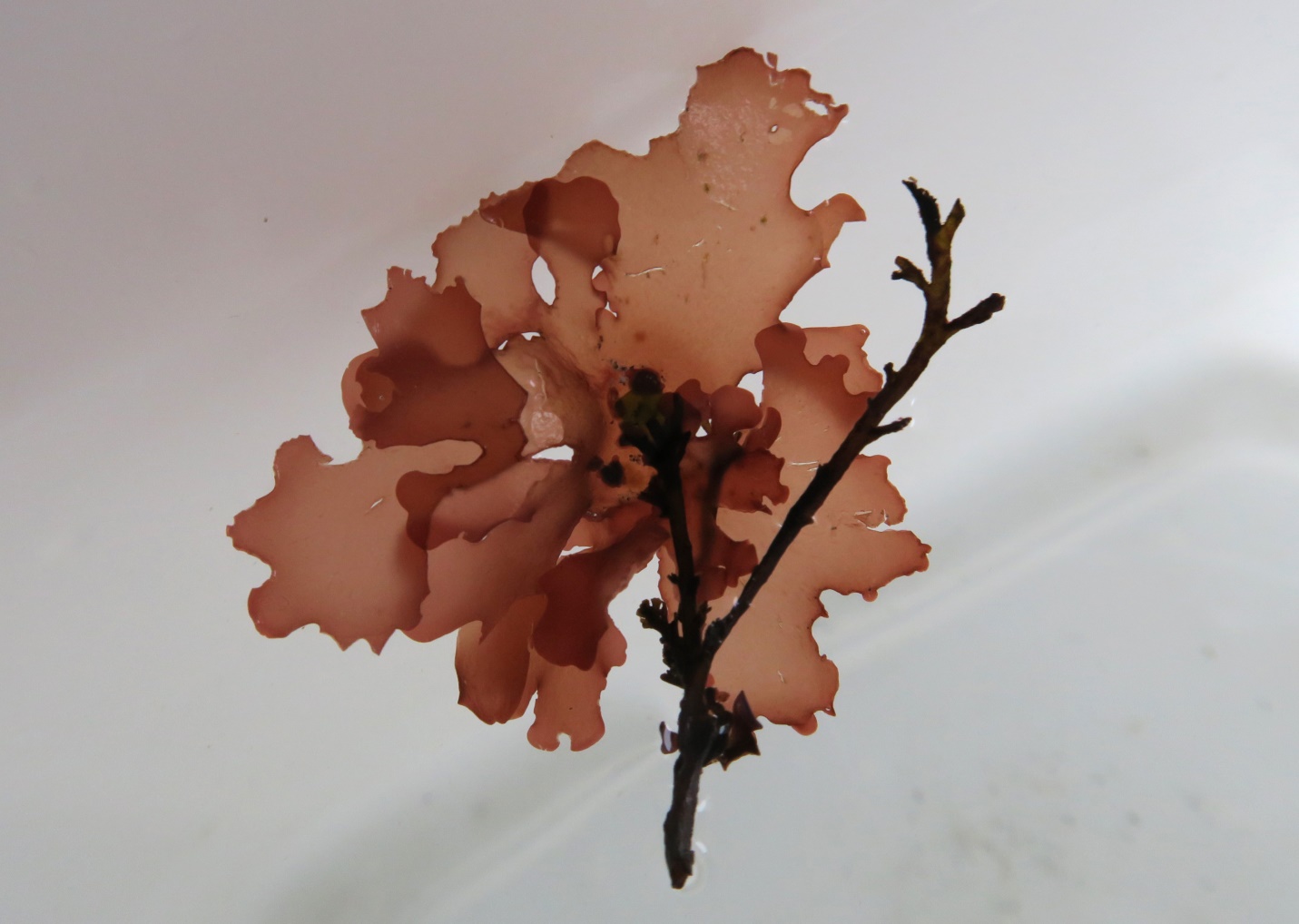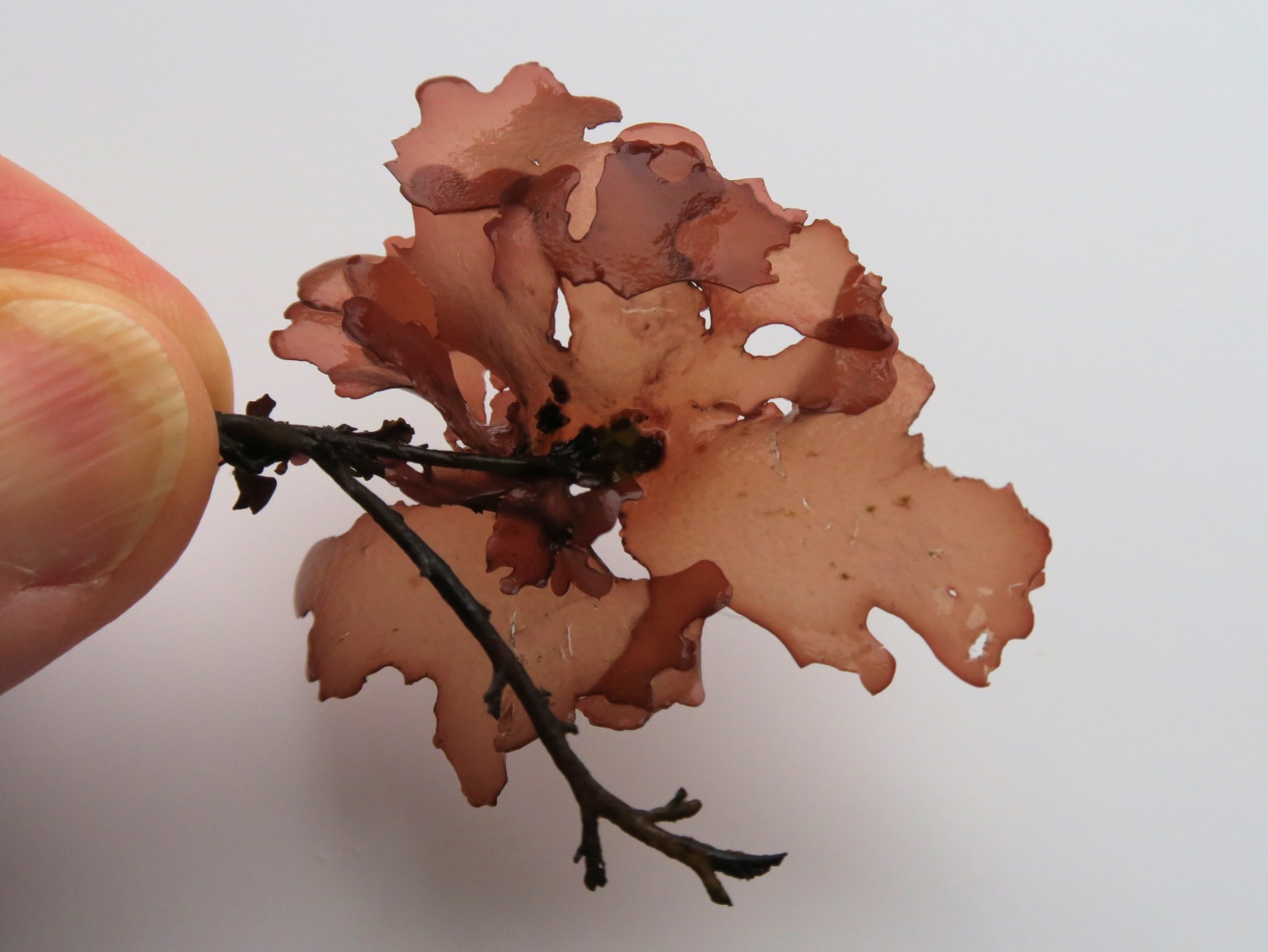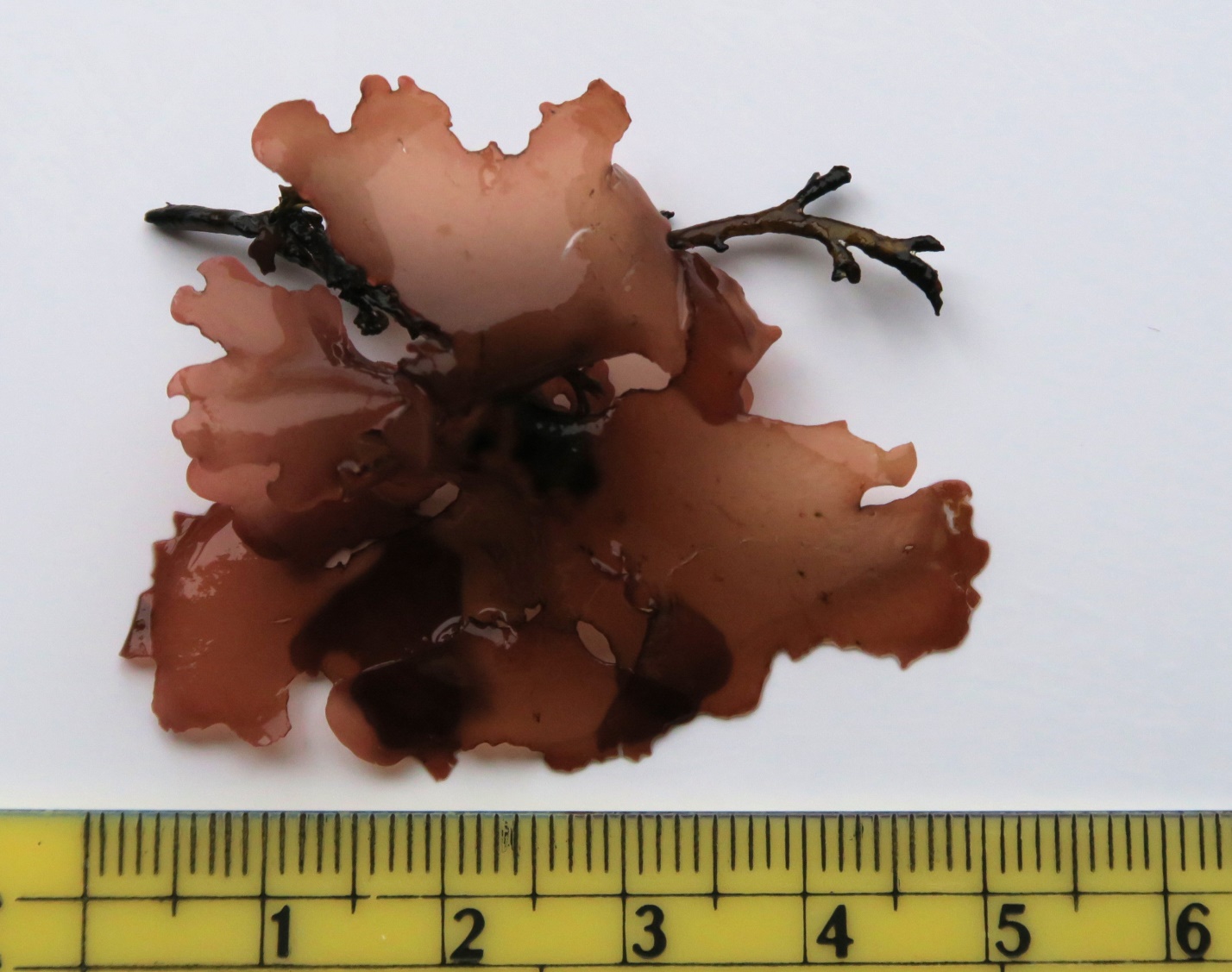
Salishia firma
Signature Salishia
Specimen Collected after it washed ashore at Gonzales Bay, Juan de Fuca Strait, B.C., Canada.
Tide: 7.9 foot tide 08:30 am PST (measured at Oak Bay Tidal Station)
Conditions: Overcast, light drizzle, wind light variable, sea rippled, humidity 96%, 8˚C.
Most interactions and observations compiled 28 November 2021
Moon: Waning Crescent (approx. 24 hours into this phase at time of interaction); Previous Phase, Third Quarter, 27 Nov 2021 at 04:27 am PST: Next Phase, New Moon, 3 Dec 2021 at 11:43 pm PST.

Figure 1: Salishia firma, larger than life size, out of water, this image shows the top side of the algae and also the texture and morphology of the blades. Gonzales Bay, Juan de Fuca Strait, B.C., Canada. November 27, 2021. Photo ID 27483 ©Seaweedwhisperings.com
Person 1:
I’m captivated by its name. I feel at home with the name. I’m sure its genus, Salishia, is named for the Salish Sea which is nearby. ‘Firma’ brings up several connotations. One, FIRM-ly anchored. Two, strong in its convictions/ideas. Three, in Spanish ‘firma’ means ‘signature’ which seems to match point two.
Living mainly sub-tidally and lying more prostrate than upright, I imagine it hidden beneath the large kelps. Lying flat would make it less susceptible to being torn off the substrate.
So…, I see characteristics of this seaweed’s energy to include:
Strong, not going to budge from convictions or way of being.
Hiding, but not knowing from what.
Outwardly showy (if it is visible) but conservative beneath.
Our set-up for this Whispering is very organized physically – location of bucket, scooping spoon, drying towel, notebooks, etcetera. My printing is neater than usual, as are my notes. This neatness, in my printing, came from my going more slowly.
Now I took a very brief look at the Salishia in the collection bucket. I had seen Person 2’s photos and collection of identification references, thus felt I didn’t yet need more physical connection with the specimen. I did like seeing the rosy translucent appearance of the seaweed, so will want a closer look soon.
Now as I engage in a closer look, the overall form is rather beautiful, at least from a distance. But when I look closer, it is rather ugly, err..., maybe not UGLY, but certainly unattractive to me.
Very smooth, slightly slimy to the touch when freshly out of water.
Although I’m attracted to its outward beauty, I’m not particularly interested in a close relationship. I contrast that with my sensual attraction to Opuntiella. I think I’ll just leave Salishia in its own world.
Seems like I’m more “reacting to” this seaweed’s energy than exploring it. I wonder if it repels to protect itself.
I became very sleepy; sat in a comfy chair and almost fell asleep. I woke up well-rested this morning, so not sure why I feel this sleepiness. Maybe it’s the feeling of “at home” comfort I sensed from the seaweed’s name.

Figure 2: Salishia firma, floating bottom-side up in a bucket of seawater. November 27, 2021. Photo ID 27484 ©Seaweedwhisperings.com
Person 2:
I found this seaweed washed ashore and in the drift at Gonzales Bay yesterday morning.
It stood out – as something I don’t see every day. The translucent red, the unusual form of the blade, the absence of a stipe (at least any that I could see), the feel of the blades…, though small and seemingly thin enough to let light through, the blades have surprising amount of substance and body to them.
I decided to collect it in a bucket of seawater and bring it home where I could study it more closely.
As I was touching the blade when I photographed this seaweed I soon also noted how there’s a very fine pebbled texture to the surface of the blade surfaces, possible granular is another word, but the overall feel is that my finger glides over and slips right off of the slick blade surface.
This specimen had drifted ashore entire and largely undamaged. We can observe it in situ – just as it had been growing affixed epiphytically to another cylindrical-stemmed dark red-colored alga (probably a species of Odonthalia). Even looking closely with a magnifying lens I can’t really see the holdfast – it is that small and inconspicuous. Yet, it held Salishia firma well and firmly in place; it’s just that the anchor alga was somehow ripped from its mooring and so Salishia’s fate is closely entwined with an ‘other’.
I picked you up again – you’re very slippery, almost as if coated with some invisible mucilage or ‘grease’ and beneath that smoothness is the very fine pebbled texture. This firmness of texture, the translucent blade, along with the mucilage coating and finely pebbled / grainy surface, I could almost liken this to a certain kind of leather finish. But some of the qualities are paradoxical as who would expect leather to be translucent? Or for a pebbled surface to be so slippery?
Your color is a soft red, and your blade takes on a broadly oval or circular shape overall but splits out into irregular shaped lobes. There are a few such blades clustered at the point of attachment. Taken all together they remind me of a flower, a pansy, violet or African violet. The outline, the indentations of this seaweeds lobes, are like some moderately frilled African violet flowers I’ve seen. The only thing missing to make this look very flower-like is that there is no ovary, stamen, stigma – none of the central ‘sexual’ parts of the flower. What you have, Salishia, is the look of the sepals and petals of such a flower only. Is sexuality not yet developed in this energy, or only very hidden? One can “see” the area where it should be, but it is not yet present, there is nothing there.
Where your blades overlap your soft red “doubles up” and becomes a deeper shade on the same tone. I do note that we have no way of knowing how long you have been adrift and more importantly stranded ashore. Your overall coloration could be a bit different, if we could see you growing undisturbed in your subtidal habitat.
And your habit seems to be to grow horizontally, not vertically really at all. You reach out, not up. This must be where your “firm” blades come in handy; if they were more flimsy of texture they’d surely droop. But this is not you. Your blades reach out firmly and with suitable flexibility; you do not have any stiffness or brittle qualities as such, but you do hold your shape.
I can’t perceive a smell from you and I don’t feel moved to taste you. You’re small enough that if I did we’d have little left to work with!
When I researched references to identify your species name I learned that like many ‘reds’ you like the very low intertidal and even subtidal regions to a depth of 10 meters. I think you therefore can do very well with low light that is filtered through the sea above you.
Perhaps you’re a bit shy.
Perhaps you prefer to not be seen in strong, full light.
Or maybe it is also that you prefer that your environment be pretty much the same, predictable, and free from sudden changes.
You reach out, firmly and with a bit of ‘frilly-edged’ style, but you aren’t seeking attention.
You don’t grow to a very large size, either, and as such I think you’d be lost in the company of the algal ‘giants’ that thrive in the low-intertidal zone.
I just checked and found that your blade is actually translucent enough that if I put it atop my written words here I can read right through a single blade.
Your lobes are quite irregular but also quite attractive. It’s like there’s no ‘set pattern’ to conform to but you do have an overall preference for your shape and thus there are limits within that randomness.
The horizontal growth is outward, yes, and it is also slightly convex. There is a distinct underside to your very slightly ‘cupped’ blades and it is on this underside that small, new blades can be seen starting to fill out.
If I take hold of the stem of the algae you are anchored to and move you up and down in the bucket your blades do waft a bit in response to the direction of movement, but if I hold you still, suspended in the water, your blades float perfectly out, flatly splayed for maximum horizontal exposure. Wide open to receive the light, in an environment where that light is guaranteed to be soft and filtered.
The fine pebbled surface of your blades makes me think it may be connected to natural buoyancy like personal floatation devices (life-jackets) that were once made of kapok and now seem to be some sort of air-filled foam. Possibly this structure means you float rather quite naturally and therefore don’t have to use strength to hold your position. Much less work / effort is needed for that. Yes, this fits you – find the easiest way, the method with least exertion to achieve your goal / purpose.
You’re unassuming yet blatantly there.
You’re spread wide open yet not overtly assertive at all.
You have a lovely “look” but it somehow isn’t quite complete and defies easy categorization.
In looking at this Whispering, I think I came to understand this seaweed in a way as if I was circling around knowing it. It was as if there were themes, such as “grows horizontally” and each time I returned to that theme I could go a bit deeper. I couldn’t go directly deeper. My access needed to involve this kind of taking a look, moving on, returning to take another look, seeing a bit more, moving on again…, and in this manner I could gradually gain some deeper understanding.

Figure 3: A view of the same specimen of ‘Signature Salishia’ as above but seen from the underside. November 27, 2021. Photo ID 27485 ©Seaweedwhisperings.com
Discussion:
Key aspects of this seaweed include:
Settles in place, and that’s it.
Reaches out but passively (has a lazy feel).
Holds up but only as a result of inherent physical structure (not due to individual work or effort).
Hidden or lies low in the deeper or darker regions.
If interested to try, one must circle round and keep coming back to it, in order to get to know it.
Has inherent beauty and is attractive when seen from a distance, but also looks ragged or as if the external (appearance) is often neglected and also, rather oddly, seems as if it is missing some parts.
Person 1 didn’t quite want to describe the look of this seaweed as ugly; he hesitated to use that word. There is an aspect to the energy of this seaweed that reflects the ‘memory’ of having been previously injured and this creates a hesitancy in others to “call a spade a spade”. While there is a strongly blatant expression physically with this seaweed – a open and unashamed, the internal and deeper character does seem to be very sensitive to what others think of them.
Is Salishia then a bit of an outlier? Not that active, outwardly ugly or at least unkempt, sometimes a bit lazy, often not noticed much. Does it reside in its own world, a bit dimly lit, a bit deeper from view and therefore possibly slip into a world of its own – one that is maybe not so easy for others to ‘know’ or that is not so interesting to many others.
The slippery feel of the surface of the blades seems to match the slipperiness of grabbing ahold of any quick understanding of this seaweed. And there is a bit of a sense that this is Salishia’s way of repelling others, as a protection and a distancing mechanism. Perhaps Salishia is accustomed to being misunderstood by others and then also judged and rejected as being inconsequential or simply not useful to engage with or work with.

Figure 4: Specimen laid out for size comparison. This image shows some of the ‘smooth and slimy’ qualities of this red alga. November 28, 2021. Photo ID 27486 ©Seaweedwhisperings.com
Biology & Natural History Information:
Description:
The thallus of this red seaweed is relatively thick with a vaguely circular shape and irregular lobes. The tiny holdfast measures only 1 mm wide and is usually attached to the blade directly, though occasionally the blade may be connected via a short stipe. It grows to 18 cm tall, and tends to lie across the substrate instead of growing upwards.
Habitat:
This species has been recorded growing on rock in the low intertidal and uppermost sublittoral (subtidal to 10 meters) zones. It is also occasionally found growing on marine invertebrates, seagrass and other macro algae.
Range:
Salishia firma has been recorded at multiple locations along the coast of British Columbia and at one location in California.
Remarks:
Salishia firma is the type species (holotype) of the genus Salishia.
Records as Collophyllis firma (a synonym of Pugetia firma and before the Salishia genus was defined) ranging from Alaska to California are likely not S. firma as it has been newly (Clarkson and Saunders (2012)) defined.
Classification:
Phylum: Rhodophyta
Class: Florideophyceae
Order: Gigartinales
Family: Kallymeniaceae
Genus: Salishia
Species: Salishia firma (Kylin) Clarkston & G.W.Saunders 2012
Former name(s): Pugetia firma Kylin 1941; Callophyllis firma (Kylin) R.E.Norris 1957
![]()